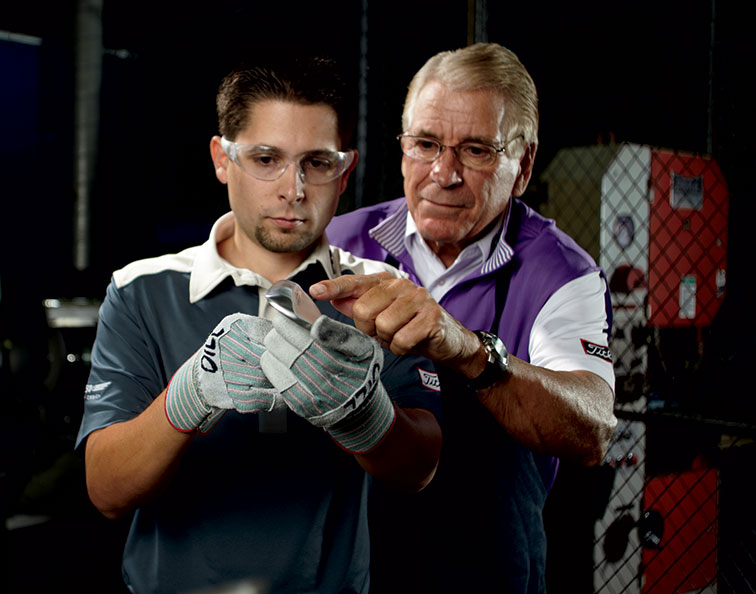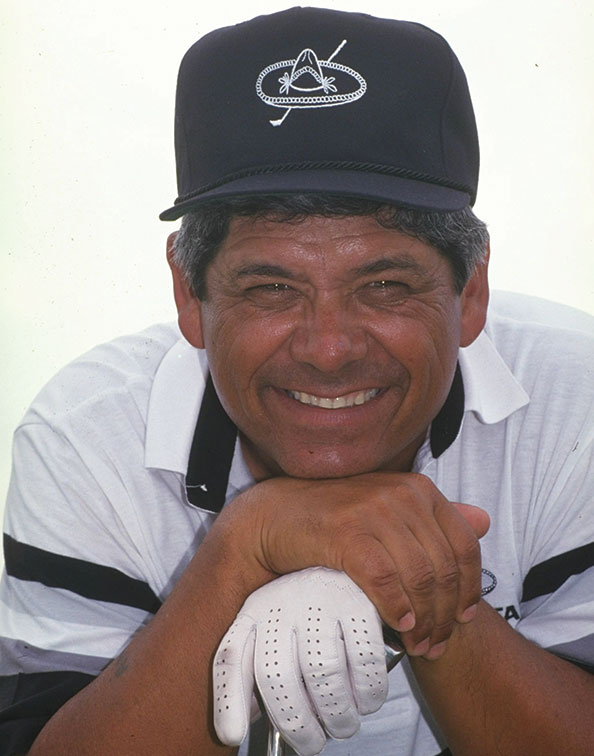This month Australian Golf Digest reveals its gold and silver-medal winning wedges in the 2016 Hot List. At the forefront of this rating over the past two decades has been Titleist’s master craftsman Bob Vokey. As you’ll learn over the coming pages, what started off as a hobby quickly developed into a passion and later, a legend. The 76-year-old sat down with AGD editor-in-chief BRAD CLIFTON recently to talk about life as a leading wedge designer, the best short-game players of all time and why the new Vokey SM6 will change the game.
GREW up in Montreal, Canada. I was a hockey, football and basketball player, not a golfer. My dad happened to be an avid golfer and wanted me to play. I remember playing my first full round of 18 holes when I was 12 years of age. I shot 107. Dad made me count everything.

DAD was always tinkering with golf clubs at home. My interest in the art of club design started there, in Dad’s shed. That interest peaked when I came to the United States in 1966. I got to know a friend of mine at a golf course and I thought I could play a bit back then until I saw these young guys hitting irons into holes that I was hitting fairway woods. It was then and there I thought, Hang on a minute, I’m not that good. So I went and worked for another club and the next thing I know I’m picking up range balls and thought that wasn’t going to be my forte either. I then went and worked in the back room and started tinkering with golf clubs. I began dabbling in club design, reading everything I could about it. After a while, Dad moved and opened a little golf shop in Fallbrook Country Club in San Diego County and later in 1980, he moved to a larger location in Vista, California. There we started finishing woods, doing weight placements and changing weights…Then one day Gary Adams, the father of the metal wood, walked into my shop and asked me to do their repair work. I couldn’t refuse.
MY FIRST wedge came in 1997 after I was approached by Titleist in 1996. They initially wanted me to help out with the 975D Driver, which I did. Then one day I asked them what they wanted me to do next and Wally Uihlein (CEO and chairman of Titleist’s parent, Acushnet) suggested I do wedges, to which I replied, “I’d love to. Let’s go!” He gave me all the resources and time to put the project together. I had so many ideas – myths that I wanted to dispel. I went out on tour and worked with the players to see what worked and what didn’t. I wanted to know what they wanted in a wedge. That’s how I learned and it’s how I gained respect. You’ve got to gain tour players’ trust for them to use your product.
I GREW up in a time with 50-degree wedges and I guess I saw an opening with different lofts and grinds. I liked grinds and experimenting with different bounce combinations. Back then you picked an oversize part and manually grinded it. Today you have computers that do it all. It’s amazing.

I’VE worked with so many great players over the years, but Lee Trevino [left] was one of my favourites … a real character. He knew what he wanted in his gear. Back in the day he’d often come into the golf shop and people would see him out the back with me tinkering with clubs. He’d yell out to them, “It’s OK, I’m just a little Mexican. Bob get’s me some tacos and burritos for lunch. How you doing?” We did a lot of tinkering together and a lot of inspiration behind my series 200, 300 and 400 clubs came directly from Lee, along with Seve Ballesteros. When it came to the knowledge of playing shots, there was no comparison to Seve. In 2000 he called me and said he wanted to see me. He had a set of irons that needed loft adjustments. He came in, picked up each iron, held them out in front of him and closed one eye before going through each loft request. One degree flat, half a degree up … you name it, Seve went through each iron and set the loft by eye. To this day I’ve never seen that topped. I checked each club and he was spot on.
WHO are the greatest wedge players I’ve seen? I may be a little prejudice but I like two of the greats, Trevino and Ballesteros. But Tiger Woods in 2000 was untouchable. Brad Faxon and Steve Stricker have both been great to work with. The thing I’ve really
noticed about today’s players is they’re finally learning about trajectory. Young players like Jordan Spieth, Justin Thomas – all great short games. Brett Rumford is another. Why? They all realise the importance of the different grinds and having the right grinds for the course they’re playing.
AMATEURS are getting better at understanding the importance of grind, bounce, lofts, turf interaction, sand conditions – all the components that come with using wedges the way they were designed to be used. We’ve worked hard to educate this and they are starting to realise that bounce really is their best friend out on the golf course.
I’VE had flags sent to me from Masters winners saying, “Thanks for helping me win this”. But, as a designer, what turns me on more than anything is when I walk into a tournament and a weekend golfer comes up to me and says, “Mr Vokey, I just bought one of your wedges and it’s completely changed my game.” That really turns me on. That’s what keeps me going in this business at 76.

WHY wedges? Personally I know I get more of a thrill holing out or hitting it close than bombing a275-metre drive. That’s why I have such a great passion for wedge design because it’s the most important part of the game. Not everyone has the physical ability to hit the ball 275m-plus like Adam Scott. But everyone has the physical ability to have a great short game.
THE dreaded leading edge is the most common mistake I see amateurs make with the wedge and it’s generally a direct consequence of leaning the shaft at address. They don’t trust the club and don’t use the bounce correctly. In contrast, the biggest mistake guys on tour make is thinking they can pull off a shot they shouldn’t even be attempting.
TIGER hit the best wedge shot I’ve ever seen back in 1999. I remember he flubbed his first attempt in the rough. He refocussed, stepped over the ball again and canned it. That was pretty neat to see him hole out to save par after making an error. Of course, Bill Haas chipping out of the water to win the 2011 Tour Championship and FedEx Cup would be right up there, too. I can’t believe he even attempted that shot.
I REMEMBER bumping into Andy Bean last year. Back in 1997 Andy saw me out on the course with my 456 prototype wedge. He grabbed it out of my bag, hit it and immediately said he had to have it. He put it in play that week. Anyway, last year at Bay Hill he came up to me and said, “Hey Voke, you know I still have the first Vokey wedge ever put in play on the US PGA Tour. I’d like you to write me a nice letter and I’ll donate it to the World Golf Hall of Fame.” I still haven’t got around to writing it yet, but I thought that was pretty cool. Ten million wedges later, here we are today.
I DON’T like making predictions these days. I once told a guy who went off to work for another golf company that he was making a huge mistake and that they would never replace Persimmon … ever. That was the first of many predictions that backfired on me. The graphite shaft was another. That will never work, I said. Metal woods? Nobody will pay $500 for a metal wood. Another one was my idea for a 64-degree wedge. I thought the 64 was great and would be the saviour for players hitting the toughest shot in golf. Well, that lasted about two years and isn’t in my line of wedges anymore. So after those four predictions, I say to my guys, “Let’s just stick with what we know.”

MY NEW SM6 wedge is a game-changer. By moving the CG (centre of gravity) down lower in the SM6 we gained distance back, distance we lost earlier generations of Spin Milled Wedges. The SM6’s weight pads are the key. We could have put it in the first Spin Milled wedges but we would have had to change the head shape drastically so we weren’t ready. With the SM6, which you’ll see in this year’s Hot List, we improved all the grinds. The F Grind has a full sole with medium to high bounce, the M Grind has a heel, toe and trailing edge grind for maximum versatility, the S Grind has a trailing edge and heel grind that provides stability on full shots, the L Grind is a little narrower and is great on firm surfaces with less bounce, while the K Grind the fullest and widest sole we have. But get this – back in 2012 Adam Scott was struggling with his wedges so I handed him our K Grind. I said, “Try it but please don’t look at the sole.” He swung it and it went BAM! He said, “No way!” A year later, a week before The Masters, Adam put a new one in his bag and we all know what happened there. If they’re good enough for the best players in the world, they’re good enough for anyone.
The M Grind is the most versatile wedge we have and my personal favourite. We have it in 54, 56, 58, 60 and 62 degrees. It’s a great wedge, in the mid-bounce category and you can hit a lot of shots with it.
What are we going to look for in a great wedge in 10 years’ time? First and foremost, I hope I’m still alive. Jokes aside, we’re going to see more of what we have now. We’re going to continually work with grind, CG, scorelines and, importantly, new materials.
The best piece of advice I can give anyone looking to become a better wedge player is go get fit for clubs, particularly your wedges. We educate our fitters here at Titleist to make sure the fitting experience is perfect. You really do get everything you need when you see a fitting specialist. So make sure you check out Titleist.com.au and find your nearest Titleist fitter, there’s over 200 of them around Australia and New Zealand.



